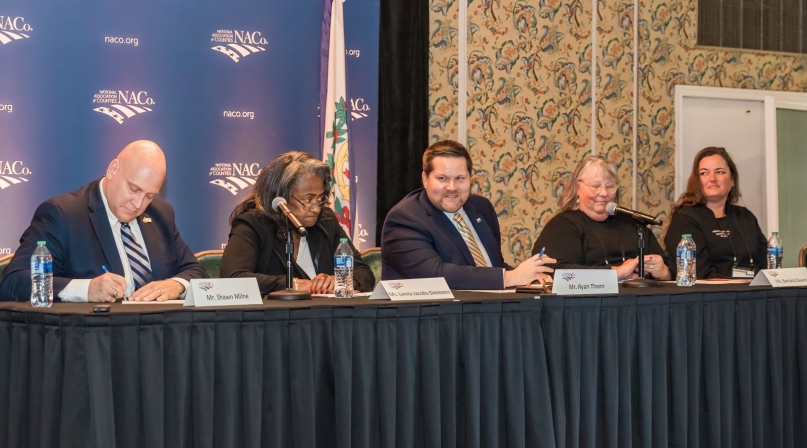Lack of broadband, housing challenge rural counties on workforce development

Key Takeaways
Although the lack of broadband, transit, childcare and housing are all stacked against rural counties as they develop the kind of robust workforce that can attract business, planning and relationships between state and local government can help alleviate some of those challenges.
That’s the assessment various practitioners in the workforce development field offered during the Rural Action Caucus Symposium in Greenbrier County, W.Va. And it’s not just about who is available to work now.
“When we talk about workforce, we’re thinking about not only people that we need to be able to staff operations, but then what does the pipeline look like?” said Jessica Breaux, Amazon’s manager of economic development.
And that pipeline may not be producing work-ready applicants.
“I think a lot of the problem is that there is a lack of training for people going into the workforce,” said Barbara Dawes, executive director, Region 1 of West Virginia’s Workforce Development Board.
“Not everyone is college material,” she noted. “They don’t want to go to college, they can’t wait two to three years to be able to get a degree. They need money now.”
Her organization helps secure on-the-job training to split the difference between expediency and the need for preparation, but the challenge is many rural areas don’t have the population that can produce enough suitable job candidates, even with training.
West Virginia faces steep challenges in delivering broadband connectivity to residents, given both the population distribution and the geography.
“Internet does not go down into some of the hollers in West Virginia,” Dawes said. “You can’t get broadband through solid rock.”
Breaux said that could be a deal breaker for employers.
“Given lack of broadband infrastructure, it’s really difficult to have an expectation of your constituents and people that live in rural communities to be able to compete and be prepared for not only jobs that are available to them today but jobs that are coming to them tomorrow without access to that broadband infrastructure,” she said.
Without housing and support services, there’s nowhere for potential workers to live.
“Where are those 800-plus employees going to live” that a prospective employer may need? asked Ryan Thorn, USDA Rural Development director for West Virginia.
“In some areas, you have to drive an hour, an hour and a half for access to healthcare. At the same time, we are seeing consolidation of health services, independent rural hospitals are becoming fewer and fewer. A private company won’t make an investment in an area that lacks healthcare and education for employees.”
The long distances and lack of regular transit opportunities in rural communities can end career ambitions for people who don’t own cars or who would have to travel far to access childcare.
“We do not have walking communities in a lot of rural areas, so there is the 15-, 20-, 30-, 40-, an hour-long walk for someone that doesn’t not have a driver’s license because of their past, it’s very hard for them to get a job unless they live within walking distance,” said Tammy Jordan, president of Fruits of Labor, Inc., a culinary and agriculture training program for adults suffering from addiction.
Breaux summed up the perspective employers bring when scouting rural communities, and the importance of government cooperation in preparing an area.
“When we are making site location decisions, we are thinking a lot about workforce, we’re thinking a lot about real estate and we’re thinking a lot about what kind of local and even state partnerships. Do we have to sort of make these ideas of fulfillment centers or last-month delivery stations become reality?” she said.
But at a time when many rural residents, let alone elected officials, are on the older side, it’s important to involve young people in planning government programs aimed at keeping them in communities.
“If young people want to go to New York City, to Los Angeles, to Charleston, S.C., any of those larger places, we need to have things in our area that they want, to keep them here,” said Lenita Jacobs-Simmons, the deputy assistant secretary for the Employment and Training Administration at the U.S. Department of Labor.
“I’m 62 years old,” she said. “What I want in my community is different than what an 18-year-old wants in their community. I’m not talking about huge things, but small things that make them different and interesting. Things that communities build makes them more interesting.”
Because many rural communities build around a particular resource or employer, there’s a tendency to focus on that element, but Breaux, who worked in economic development for the Tennessee Valley Authority before Amazon, warned against that tunnel vision and still sees that pitfall.
“I feel like a lot of the rural communities that I work in, you’ll have one-to-two major employers that your entire sort of local economy is tied to, which is not necessarily a bad thing, right, but it does present, I think, a risk, that in a changing environment, what happens to something happens to that large employer,” she said. “So how are you as a rural community preparing yourself for development?”
Related News

Podcast: Developing your county workforce
Counties are finding a renewed interest in professional development as a feature of their careers.

CMS announces Rural Health Transformation Program funding
On December 29, the Centers for Medicare & Medicaid Services (CMS) announced $50 billion in awards over 5 years to all 50 states under the Rural Health Transformation Program.

Senators introduce bipartisan UPGRADE Act to support small and rural public water systems
On December 15, Sens. Lisa Blunt Rochester (D-Del.) and Roger Wicker (R-Miss.) introduced the Unincorporated Partnerships for Grant Resources, Assistance, and Drinking Water Enhancements (UPGRADE) Act (S. 3465), a bipartisan bill that would strengthen federal support for small public water systems and helps unincorporated communities access clean and affordable water.
Resource
Counties and the American Rescue Plan Act Recovery Fund: Workforce Development

